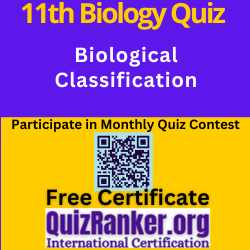Ace your 11th Biology exam with our comprehensive Biological Classification MCQ Test for Chapter 2. Challenge yourself with questions on kingdoms, taxonomy, and organism categories in this focused Biology MCQ Test.
Biological Classification MCQ Test
Attempt Chapter wise 11th biology MCQ Test and Monthly Quiz contest of Biology 11th grade.
Check Chapterwise 11th Biology MCQ
Chapter 1 The Living World MCQ Test
Chapter 2 Biological Classification MCQ Test
Chapter 3 Plant Kingdom MCQ Test
Chapter 4 Animal Kingdom MCQ Test
Chapter 5 Morphology of Flowering Plants MCQ Test
Chapter 6 Anatomy of Flowering Plants MCQ Test
Chapter 7 Structural Organisation in Animals MCQ Test
Chapter 8 Cell The Unit of Life MCQ Test
Chapter 9 Biomolecules MCQ Test
Chapter 10 Cell Cycle and Cell Division MCQ Test
Chapter 11 Photosynthesis in Higher Plants MCQ Test
Chapter 12 Respiration in Plants MCQ Test
Chapter 13 Plant Growth and Development MCQ Test
Chapter 14 Breathing and Exchange of Gases MCQ Test
Chapter 15 Body Fluids and Circulation MCQ Test
Chapter 16 Excretory Products and their Elimination MCQ Test
Chapter 17 Locomotion and Movement MCQ Test
Chapter 18 Neural Control and Coordination MCQ Test
Chapter 19 Chemical Coordination and Integration MCQ Test
Brief Summary for Biological Classification MCQ Test
Biological classification began with Aristotle, who used simple physical traits. Later, Linnaeus classified organisms into two kingdoms: Plantae and Animalia. Whittaker expanded this to five kingdoms: Monera, Protista, Fungi, Plantae, and Animalia, based on cell structure, body organization, nutrition, reproduction, and evolutionary relationships.
- Monera: Includes bacteria, which are found everywhere and have diverse metabolisms. They can be autotrophic or heterotrophic.
- Protista: Includes single-celled eukaryotes like algae, protozoa, and slime molds, with a defined nucleus and membrane-bound organelles. They reproduce both sexually and asexually.
- Fungi: Includes organisms like molds and mushrooms. They are mostly saprophytic, feeding on decaying matter, and reproduce both sexually and asexually.
- Plantae: Includes all eukaryotic, chlorophyll-containing organisms such as algae, mosses, ferns, gymnosperms, and flowering plants. They exhibit alternation of generations.
- Animalia: Includes multicellular, eukaryotic organisms without cell walls. They are heterotrophic and mostly reproduce sexually.
Viruses, viroids, and lichens are not classified within these five kingdoms.
Source for Study
Total Views: 7


